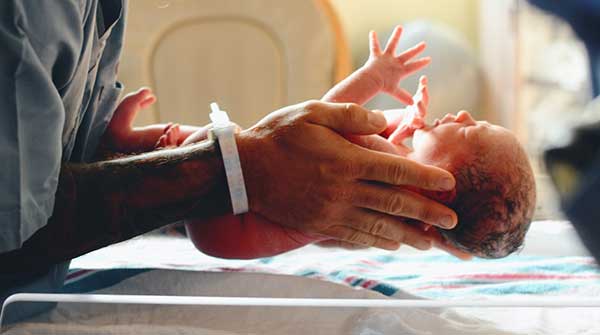Contamination actually occurred during vaginal delivery, clinical procedures or DNA sequencing
Scientific claims that babies harbour bacteria while still in the womb are inaccurate, according to University of Alberta researchers involved in an international study.
The perspective paper, published in Nature, should settle a debate in the research community about whether a fetal microbiome exists, solving a “basic question of science,” says microbial ecologist Jens Walter, adjunct professor in the Faculty of Agricultural, Life & Environmental Sciences.
|
|
 |
“It gives us a basis to understand our earliest encounters with microbes, which are so important for human development. And it confirms that the acquisition of gut bacteria happens during and after birth, not at conception or during pregnancy.”
The widespread agreement reached in this new paper among key international experts provides robust assurance for the scientific community. It also encourages researchers to focus their efforts outside the womb, on microbiomes of the mothers and their newborn infants, says Walter.
“This consensus provides guidance for the field to move forward, to concentrate research efforts where they will be most valuable. If we know the fetus is in a sterile environment, that means colonization by bacteria happens early in life, and that’s where research that concerns infant health needs to be focused.”
The human body is home to millions of microbes that are important for health in several ways, including protection against infection.
The prevailing belief that has guided research in this field is that the uterus is a sterile environment and that babies don’t start to develop a microbiome – a community of gut bacteria – until they are born. But that was questioned when several papers published after 2010 reported that microbiomes were found in the fetal environment, including the placenta and amniotic fluid, Walter says.
That led to the theory that a fetal microbiome existed, but it was a troubling assumption given that any bacterial infection would likely be fatal to a fetus and possibly the mother, notes U of A researcher Michael Gänzle, who also contributed to the new paper.
“The fetal immune system wouldn’t be able to control the bacterial infection.”
To clarify whether a fetal microbiome exists, a team of 46 leading experts from around the world, including Walter, Gänzle and fellow U of A researcher Maria Elisa Perez-Muñoz, evaluated the only four known studies specifically focused on the topic. Two of the studies supported the existence of such a microbiome, and two concluded that it didn’t exist at all.
The group of scientists reviewed the methodology of the studies through a multi-faceted range of biological lenses to learn more about how the fetus might be interacting with microbes.
The team unanimously concluded that the detection of microbiomes did not stem from the presence of microbes in the uterus itself, but was the result of microbial contamination of the samples drawn from the womb. Contamination occurred during vaginal delivery, clinical procedures or DNA sequencing.
“We were able to see where mistakes were made in sampling or contamination controls that resulted in the false conclusions that a fetal microbiome exists,” says Gänzle.
The paper also points out the pitfalls of examining other samples with no or low levels of bacteria, such as internal organs and breast milk, for microbial research, Walter notes.
In a sterile environment like the womb, even trace levels of bacterial contaminants or bacterial DNA are detected as microbial signals and may result in wrong conclusions – such as the existence of a fetal microbiome.
“It shows how careful scientists have to be if they study what we call low biomass samples, and it happens a lot,” Walter notes, adding that the paper also emphasizes that conclusions should never be based on sequencing findings alone, but should take into account evidence from several disciplines.
“There are many studies that are trying to figure out what bacteria are in different samples, and a lot of it is challenging.”
| By Bev Betkowski
Bev Betkowski is a reporter with the University of Alberta’s Folio online magazine. The University of Alberta is a Troy Media Editorial Content Provider Partner.
The opinions expressed by our columnists and contributors are theirs alone and do not inherently or expressly reflect the views of our publication.
© Troy Media
Troy Media is an editorial content provider to media outlets and its own hosted community news outlets across Canada.


